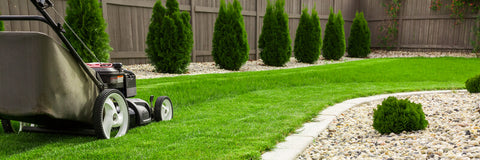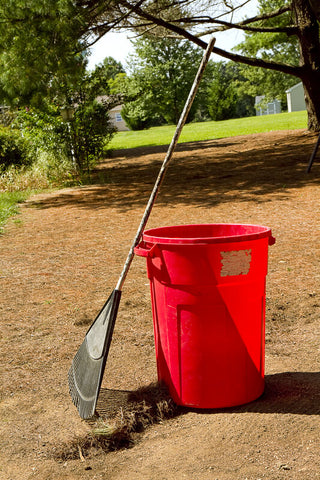Are you new to lawn care and wondering how to mow a lawn for beginners without spending hours or dealing with frustrating results? This guide provides simple tips and techniques to help you achieve a perfectly cut lawn, even if you've never used a mower before.
We'll cover everything you need to know, from picking the right beginner-friendly mower to mastering basic cutting techniques. Say goodbye to guesswork and hello to that lush, beautiful lawn you've always wanted!
Key Takeaways
- Know Your Grass: Match mowing height to your grass type.
- Pick Your Mower: Choose based on lawn size (manual, electric, gas, riding).
- Prep First: Clear debris, set cutting height (never over 1/3), check blades and fuel/charge, mow dry.
- Mow Smart: Use overlapping rows, alternate patterns, and edge for a pro look.
- Maintain Your Mower: Clean regularly and store properly.
Getting Started: Know Your Grass Type

Image Source: Dreamstime
Each grass type needs a different mowing height. Matching the height to the variety keeps the lawn healthy and attractive.
Warm-Season Grasses (Thrive in Hotter Climates)
- Bermuda Grass: This sun-loving grass thrives in hot weather and requires frequent mowing to keep it between 1 and 2 inches tall. Its dense growth habit makes it a popular choice for lawns with heavy foot traffic.
- St. Augustine Grass: This shade-tolerant grass is popular in many regions. It prefers a slightly taller height of 2.5 to 3 inches and benefits from regular mowing during the growing season.
- Zoysia Grass: Known for its slow growth and dense texture, Zoysia grass should be maintained at a height of 1 to 2 inches. Its deep root system makes it drought-tolerant.
Cool-Season Grasses (Thrive in Cooler Climates)
- Kentucky Bluegrass: This popular cool-season grass thrives in moderate temperatures. For optimal health, it should be kept at a height of 1.5 to 3 inches.
- Fescue Grass: This shade-tolerant grass is another cool-season variety that prefers a height between 1.5 and 3.5 inches. It's known for its fine texture and durability.
Understanding your grass type helps you set the correct cutting height on your mower, which is one of the most important steps for lawn success.
Choosing Your First Lawn Mower

Image Source: Shutterstock
Picking the right mower is crucial, especially for beginners. Here's a simple guide based on your lawn:
For Small, Flat Lawns
- Manual Push Mowers: Great for light exercise, eco-friendly, and very easy to maintain. Perfect for small, flat yards.
- Compact Electric Mowers (corded or cordless): Lightweight and easy to maneuver. Good for small to medium yards without tough slopes.
For Medium Lawns (with gentle slopes)
- Self-Propelled Mowers (gas or electric): These are fantastic because they "pull" themselves forward, reducing your effort. They're a good choice if your lawn is a bit larger or has some gentle inclines.
For Large Lawns (or with big hills)
- Riding Mowers: For really big yards, these are the most efficient as you simply drive them.
Things to look for as a beginner
- Adjustable Cutting Heights: Essential for different grass types.
- Mulching Feature: Chops clippings finely, returning nutrients to your lawn – less bagging for you!
- Ease of Maintenance: Electric mowers are generally simpler for beginners.
Personal Preference
Consider your physical capabilities and comfort level when choosing a mower style. Some people prefer the exercise of a push mower, while others prioritize the convenience of a self-propelled or riding mower.
Your Beginner's Checklist: Before You Mow

Image Source: Dreamstime
Good preparation makes the actual mowing easier and safer. These steps are essential for successful results.
- Clear the Lawn: Walk your entire yard and pick up anything that could cause problems: rocks, branches, toys, pet waste. These can damage your mower blades or become dangerous projectiles.
- Set Cutting Height: Adjust your mower to match your grass type's needs. Here's a golden rule for beginners: never cut more than one-third of the grass blade length at once. Cutting too short stresses your lawn badly.
- Inspect Your Blades: Dull blades tear grass instead of cutting cleanly, leaving it looking ragged and vulnerable to disease. If they look dull, get them sharpened (you might want to ask a pro initially).
Fuel/Charge Check (if needed):
- Gas Mowers: Make sure you have enough fuel and check oil levels. Your manual will have specifics.
- Electric Mowers: Charge that battery (cordless) or prep your extension cord (corded).
Choose Dry Conditions:
- Wet grass can clump together, clog your mower, and lead to an uneven cut.
- Wait until your lawn is dry before mowing for the best results.
Stay Hydrated:
- Mowing can be a physical activity, especially in hot weather.
- Remember to drink plenty of water to stay hydrated and prevent heat exhaustion.
Now that you have prepared your lawn for mowing let's move on to learning how to mow it properly!
Mastering the Mow: Step-by-Step for Beginners
With your lawn and mower prepared, you can begin the mowing process.
Instead of always mowing in the same direction, change your pattern each time. This prevents soil compaction and helps grass stand upright for a more uniform cut. Varying your rows also reduces the chance of creating ruts or worn-down paths in your lawn.
|
Safety First! |
|
Wear closed-toe shoes and long pants. Eye protection is smart too, especially if your mower doesn't have good deflectors. |
|
Fire It Up |
|
Follow your mower's specific starting instructions. |
|
Create Overlapping Rows |
|
Push your mower in straight lines, overlapping each pass by a few inches. This ensures you don't miss any spots. |
|
Change Your Pattern |
|
Here's something many beginners don't know: alternate your mowing direction each week. Go horizontal one time, vertical the next, maybe diagonal after that. This prevents ruts and encourages healthier growth. |
|
Handle Clippings Smartly |
|
Short Clippings: If you're mowing regularly and only trimming a third of the blade, leave those short clippings on the lawn. They're natural fertilizer! Long Clippings: When grass has grown tall, bag those clippings to prevent them from smothering your lawn. |
|
Edge for That Pro Look (Optional but Worth It!) |
|
After mowing, use a string trimmer or edger to create clean lines along walkways, driveways, and flower beds. This step transforms your lawn from "mowed" to "professionally maintained". |
Basic Mower Care for Beginners
A little maintenance keeps your mower happy and extends its life significantly.
- Clean the Deck: After mowing (or every few sessions), scrape off grass clippings and debris from underneath. This prevents clogging and rust issues.
- Monitor the Basics (Gas Mowers): Keep an eye on oil levels, air filters, and spark plugs. Your manual will tell you how often to check these.
- Store It Right: Keep your mower in a dry, covered spot when not in use.
Frequently Asked Questions
How often should I mow my lawn as a beginner?
Aim to mow once a week during the growing season, adjusting frequency if your grass grows faster or slower. Consistency helps keep your lawn healthy and prevents overgrowth.
What’s the best time of day to mow?
Late morning or early evening is ideal - avoid mowing when grass is wet or during the hottest part of the day to reduce stress on your lawn and yourself.
Should I bag or mulch my clippings?
If you mow regularly and only trim a small amount, mulching (leaving clippings) is best. It returns nutrients to your lawn. Bag clippings only if they’re long or could smother your grass.
How do I know if my mower blade is dull?
If grass tips look torn or brown after mowing, or your mower struggles to cut, it’s time to sharpen or replace the blade.
Can Trimyxs help with edging and trimming?
Yes! The Trimyxs universal push mower attachment combines trimming and edging in one easy step, saving you time and effort for a professional-looking finish.
Final Words for the Beginner Mower
Learning how to mow a lawn for beginners really comes down to getting comfortable with your equipment and understanding a few key techniques. Don't overthink it! Regular mowing at the proper height will transform your lawn over time.
What challenges are you facing as you start your mowing journey? Share your experiences and let's help each other achieve those perfectly cut lawns!

